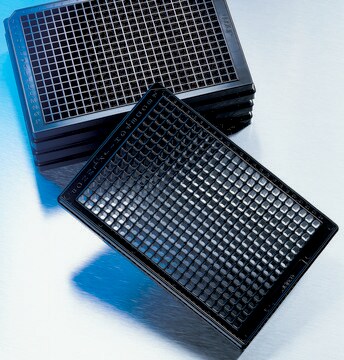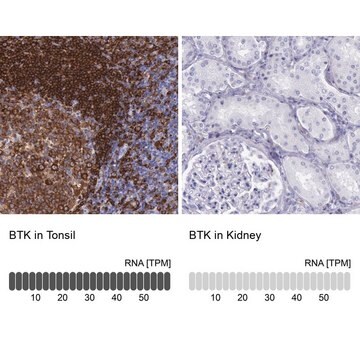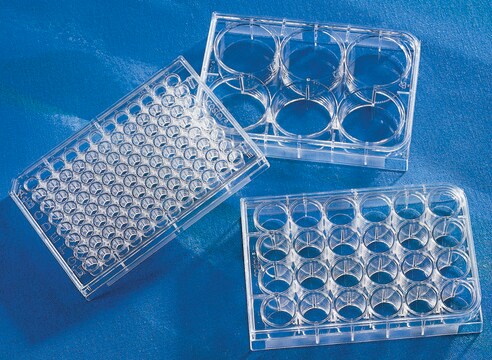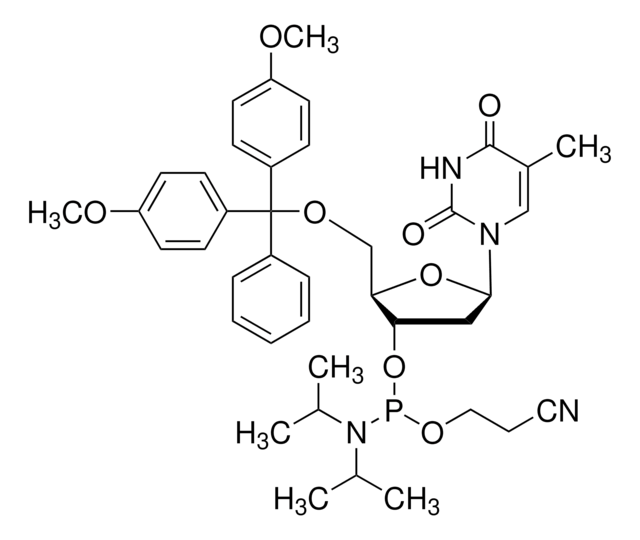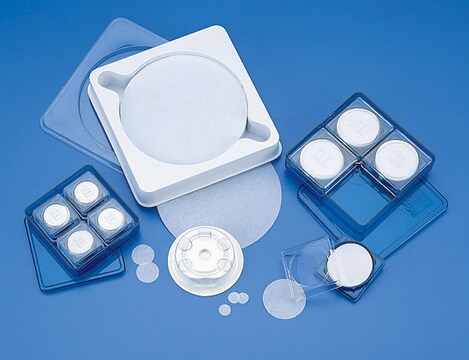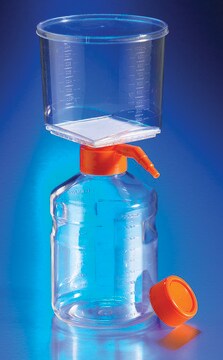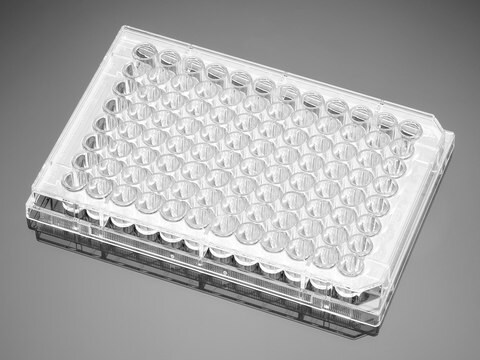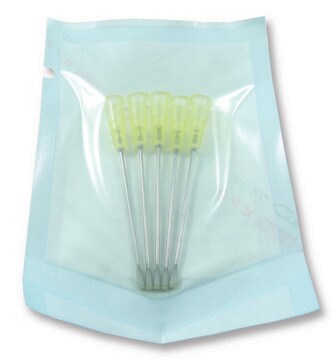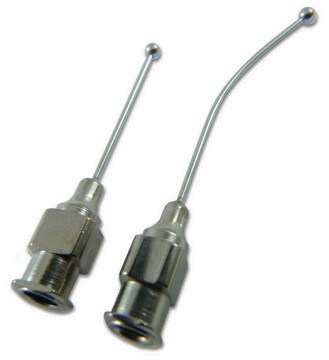HTS028M
ChemiSCREEN Membrane Preparation Recombinant Human sst2 Somatostatin Receptor
Human sst2 GPCR membrane preparation for Radioligand binding Assays & GTPγS binding.
Autenticatiper visualizzare i prezzi riservati alla tua organizzazione & contrattuali
About This Item
Codice UNSPSC:
41106514
eCl@ss:
32161000
NACRES:
NA.41
Prodotti consigliati
Origine biologica
human
Livello qualitativo
Ricombinante
expressed in Chem-1 cells
Produttore/marchio commerciale
ChemiScreen
Chemicon®
tecniche
ligand binding assay: suitable (GTPγS)
radioligand binding assay (RLBA): suitable
N° accesso NCBI
N° accesso UniProt
Condizioni di spedizione
dry ice
Descrizione generale
Full-length human SSTR2 cDNA encoding sst2
Somatostatin (sst) is a multifunctional peptide with two biologically active forms, sst-14 and sst-28, which are synthesized in neurons throughout the brain as well as in peripheral tissues such as the pancreas and the gut (Gillies, 1997). SST exerts a diverse array of effects that include inhibition of endocrine secretion, modulation of neurotransmission, and regulation of cell proliferation by stimulating a family of five G-protein-coupled receptors. Somatostatin receptor sst2 mRNA is predominantly expressed in central nervous system. Study using sst2 knock-out mice has found the increased anxiety-related behaviour while locomotor and exploratory activity was decreased in stress-inducing situations (coupled with an increase in pituitary ACTH release, a regulator of the stress response) (Viollet et al., 2000) . In the periphery, inhibition of glucagon release by sst in mouse islets is primarily mediated via sst2 (Strowski et al., 2000). In addition, endogenous sst functions through sst2 to suppress gastric acid secretion through inhibition of gastrin activity (Martinez et al., 1998). Millipore′s sst2 membrane preparations are crude membrane preparations made from our proprietary stable recombinant cell lines to ensure high-level of GPCR surface expression; thus, they are ideal HTS tools for screening of agonists and antagonists of sst2. The membrane preparations exhibit a Kd of 0.95 nM for [125I]-Somatostatin 14. With 0.75 nM [125I]-Somatostatin 14, 5 μg/well sst2 Membrane Prep typically yields greater than 20-fold signal-to-background ratio.
Applicazioni
Radioligand binding assay and GTPγS binding.
Azioni biochim/fisiol
GPCR Class: A
Protein Target: sst2
Target Sub-Family: Somatostatin
Qualità
Table 1. Signal:background and specific binding values obtained in a competition binding assay with varying amounts of sst2 Receptor membrane prep.
SPECIFICATIONS: 1 unit = 5 μg
Bmax for [125I]-Somatostatin binding: 18.9 pmol/mg protein
Kd for [125I]-Somatostatin binding: ~0.95 nM
| 10 µg/well | 5 µg/well | |
|---|---|---|
| Signal:Background | 16.2 | 36.2 |
| Specific Binding (cpm) | 58438 | 54632 |
SPECIFICATIONS: 1 unit = 5 μg
Bmax for [125I]-Somatostatin binding: 18.9 pmol/mg protein
Kd for [125I]-Somatostatin binding: ~0.95 nM
Specifiche
Inucbation Conditions
RECOMMENDED ASSAY CONDITIONS: Membranes are mixed with radioactive ligand and unlabeled competitor (see Figures 1 and 2 for concentrations tested) in binding buffer in a nonbinding 96-well plate, and incubated for 1-2 h. Prior to filtration, an FC 96-well harvest plate (Millipore cat. # MAHF C1H) is coated with 0.33% polyethyleneimine for 30 min, then washed with 50mM HEPES, pH 7.4, 0.5% BSA. Binding reaction is transferred to the filter plate, and washed 3 times (1 mL per well per wash) with Wash Buffer. The plate is dried and counted.
Binding buffer: 50 mM Hepes, pH 7.4, 5 mM MgCl2, 1 mM CaCl2, 0.2% BSA, filtered and stored at 4°C
Radioligand: [125I]-Somatostatin 14. (Perkin Elmer NEX-389 )
Wash Buffer: 50 mM Hepes, pH 7.4, 500mM NaCl , 0.1% BSA, filtered and stored at 4°C.
One package contains enough membranes for at least 200 assays (units), where a unit is the amount of membrane that will yield greater than 20-fold signal:background with 125I labeled somatostatin 14 at 0.75 nM
RECOMMENDED ASSAY CONDITIONS: Membranes are mixed with radioactive ligand and unlabeled competitor (see Figures 1 and 2 for concentrations tested) in binding buffer in a nonbinding 96-well plate, and incubated for 1-2 h. Prior to filtration, an FC 96-well harvest plate (Millipore cat. # MAHF C1H) is coated with 0.33% polyethyleneimine for 30 min, then washed with 50mM HEPES, pH 7.4, 0.5% BSA. Binding reaction is transferred to the filter plate, and washed 3 times (1 mL per well per wash) with Wash Buffer. The plate is dried and counted.
Binding buffer: 50 mM Hepes, pH 7.4, 5 mM MgCl2, 1 mM CaCl2, 0.2% BSA, filtered and stored at 4°C
Radioligand: [125I]-Somatostatin 14. (Perkin Elmer NEX-389 )
Wash Buffer: 50 mM Hepes, pH 7.4, 500mM NaCl , 0.1% BSA, filtered and stored at 4°C.
One package contains enough membranes for at least 200 assays (units), where a unit is the amount of membrane that will yield greater than 20-fold signal:background with 125I labeled somatostatin 14 at 0.75 nM
Stato fisico
Liquid in packaging buffer: 50 mM Tris pH 7.4, 10% glycerol and 1% BSA no preservatives.
Packaging method: Membranes protein were adjusted to 1 mg/ml in 1 ml packaging buffer, rapidly frozen, and stored at -80°C
Packaging method: Membranes protein were adjusted to 1 mg/ml in 1 ml packaging buffer, rapidly frozen, and stored at -80°C
Stoccaggio e stabilità
Maintain frozen at -70°C for up to 2 years. Do not freeze and thaw.
Note legali
CHEMICON is a registered trademark of Merck KGaA, Darmstadt, Germany
Esclusione di responsabilità
RESEARCH USE ONLY. This product is regulated in France when intended to be used for scientific purposes, including for import and export activities (Article L 1211-1 paragraph 2 of the Public Health Code). The purchaser (i.e. enduser) is required to obtain an import authorization from the France Ministry of Research referred in the Article L1245-5-1 II. of Public Health Code. By ordering this product, you are confirming that you have obtained the proper import authorization.
Unless otherwise stated in our catalog or other company documentation accompanying the product(s), our products are intended for research use only and are not to be used for any other purpose, which includes but is not limited to, unauthorized commercial uses, in vitro diagnostic uses, ex vivo or in vivo therapeutic uses or any type of consumption or application to humans or animals.
Unless otherwise stated in our catalog or other company documentation accompanying the product(s), our products are intended for research use only and are not to be used for any other purpose, which includes but is not limited to, unauthorized commercial uses, in vitro diagnostic uses, ex vivo or in vivo therapeutic uses or any type of consumption or application to humans or animals.
Codice della classe di stoccaggio
12 - Non Combustible Liquids
Classe di pericolosità dell'acqua (WGK)
WGK 2
Punto d’infiammabilità (°F)
Not applicable
Punto d’infiammabilità (°C)
Not applicable
Certificati d'analisi (COA)
Cerca il Certificati d'analisi (COA) digitando il numero di lotto/batch corrispondente. I numeri di lotto o di batch sono stampati sull'etichetta dei prodotti dopo la parola ‘Lotto’ o ‘Batch’.
Possiedi già questo prodotto?
I documenti relativi ai prodotti acquistati recentemente sono disponibili nell’Archivio dei documenti.
Il team dei nostri ricercatori vanta grande esperienza in tutte le aree della ricerca quali Life Science, scienza dei materiali, sintesi chimica, cromatografia, discipline analitiche, ecc..
Contatta l'Assistenza Tecnica.